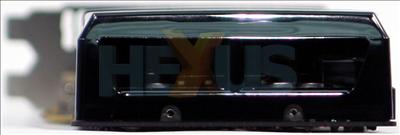NVIDIA GeForce GTX 275 896MB
In another play on cards that are already available, the GeForce GTX 275 looks eerily similar to a GeForce GTX 260. That's hardly surprising, really, because why would NVIDIA change a proven design from a cooling point of view.
Measuring in at 268mm x 110mm x 36mm (W x H x D), it's also the same size, too, but just a bit longer than Radeon HD 4890 1,024MB. For what it's worth, the porkometer read 783g.
But there's a slight difference when looking at the back. Gone is the GTX 200 family's completely enclosed heatsink. Now, the back of the card is left 'open', making it look more like a GeForce 9800 GTX+ or GTS 250, but, honestly, it doesn't make a difference. Question is, is it literally one-half of a GTX 295?
The now-familiar look of a GeForce reference card. As noted earlier, it ships with a 448-bit-wide memory interface that's connected to an 896MB frame-buffer. We're bound to see adventurous partners launch models with a double-sized 1,792MB frame-buffer, but don't reckon the GPU's potent enough to make best use of it.
It's also clocked in at reference speeds, so 633MHz core, 1,404MHz shader, and 2,268MHz GDDR3 memory, so we won't see NVIDIA adopt GDDR5 until the next iteration of DX11 cards.
The heatsink/fan is quieter than the Radeons', especially when under load.
Much like the GeForce GTX 260, the GTX 275 uses two six-pin PCIe connectors, and we can sensibly infer that maximum board power is around 182W.
TV-out gets the boot, but dual-link DVI remain. We expect to see partner-overclocked models within the next few weeks, presumably priced at £225+, matching the Radeon HD 4890 OC's price-tag.
Summary
An architecture chop from the GTX 285, expect the new GPU to benchmark at between 80-90 per cent of its bigger brother.















